By VIN Community Contributors
Managing Megaesophagus
Authored by: Dr. Kathy Morris-Stillwell
file:///E:/C%20Drive/Megaesophagus%20for%20Dummies/Managing%20ME/Managing_Megaesophagus.pdf
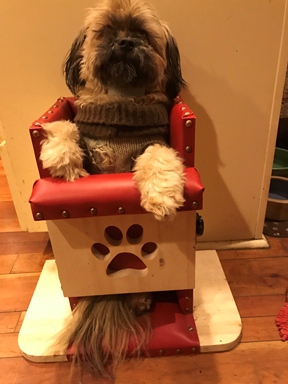
Managing a dog’s megaesophagus takes effort and can be frustrating. Familiarizing yourself with a variety of appropriate management techniques can help you provide a plan for your individual dog. This article is meant to provide management techniques while encouraging discussion between pet owners and veterinarians on how to manage an individual pet with megaesophagus, a condition of the esophagus. When a dog’s esophagus is healthy, it squeezes food down into the stomach by contracting and relaxing. In an animal with megaesophagus, the tube-like esophagus doesn’t contract. It remains paralyzed and enlarged, and it cannot push food through. The diseased esophagus interrupts the reflexes that stop the dog from breathing while swallowing. The esophagus can fill with fluid and food, which predisposes the pet aspirating the material into the lungs. Food is slow to empty from the esophagus into the stomach. The food can be regurgitated out of the mouth or it can be aspirated into the lungs, resulting in pneumonia. Pet owners can join the Yahoo megaesophagus support group to communicate with other owners of dogs with megaesophagus and with those who have found successful management practices for their affected dogs. VIN and Veterinary Partner thank the Yahoo support group for all of their efforts in developing methods for maintaining these pets in good health. Megaesophagus is more common in dogs than in cats, but the following management techniques can be used in cats and even in ferrets. Keeping a journal as to what does or doesn’t work well is helpful for both owner and veterinarian. Every dog with megaesophagus, unless it is clearly congenital (present from birth), should be tested for myasthenia gravis and Addison’s disease (hypoadrenocorticism). Less commonly implicated are lead poisoning (if you live in a house that may contain lead paint, or you use lead-based paint ceramic bowls), polyneuropathy, polymyopathy, certain parasites, and severe inflammation (esophagitis). If your efforts are not making a difference, discuss with your veterinarian whether referral to a neurologist or other specialist would be best for you and your pet. Any of the following management techniques should be discussed with your veterinarian prior to being incorporated into your treatment plan. It is usually best to change one medication or technique at a time so as not to confuse what is or is not helping.
Esophagitis
Regurgitation of stomach contents (acid) into the esophagus, especially over a long period of time, allows severe irritation of its lining, a condition called esophagitis. Prescription Carafate (sucralfate) liquid can be used as a “bandage” for the esophagus. It should be given an hour before or two hours after any other medication or food. The pet should be held vertically for at least 5 to 10 minutes after administration. The tablets, although less costly, do not seem to be as helpful, even if they are crushed and mixed with water. Esophagitis can only be diagnosed via endoscopy, which means scoping the esophagus while the pet is anesthetized. However, most cases of suspected esophagitis are treated without such diagnostics since esophagitis is common with frequent regurgitation. During an episode of esophagitis, it may be a good idea to replace any oral (by mouth) medications with available injectable drugs. Your veterinarian or veterinary technician can instruct you on how to give the injections, and there are several YouTube.com videos demonstrating injection techniques. Administering an acid neutralizer such as Pepcid (famotidine), Prilosec (omeprazole) or Zantac (ranitidine) decrease the acidity of the stomach contents. Prescription acid neutralizers can be tried. Tums and Tagamet (cimetidine) are virtually useless in effectively decreasing the acidity. Zantac also has some pro-motility effects, so it may be considered. Some pets do best with a combination of acid-neutralizers given two to three times daily. Esophagitis is very painful, so analgesics such as gabapentin or tramadol may be considered, especially during initial treatment. Severe esophagitis can result in nausea, for which prescription anti-emetics such as Cerenia (maropitant) or Zofran (ondansetron) may be helpful. Cerenia can be administered either as a pill or by injection.
Other Potentially Helpful Medications
Several other medications may help individual pets. Pro-motility drugs such as Reglan (metoclopromide), cisapride, or low-dose erythromycin can help the stomach to stay empty, which minimizes the amount of food in the stomach that can be refluxed into the esophagus. To purchase Cisapride, your veterinarian will write a prescription to be sent to a compounding pharmacy as it is not currently available through pharmacies. Rarely, a pet will have cardiac issues, which requires discontinuing cisapride. A few dogs in the megaesophagus support group have side effects from metoclopromide. They act restless or nervous, and owners report that the dogs seem to “see ghosts.” Symptoms disappear within a few hours. Either a lower dose can be tried or a different pro-motility (spontaneous movement) drug can be used. Bethanechol can help esophageal motility in a very small percent of megaesophagus cases in which there may still be some enervation. Antibiotics may be necessary if the dog has aspiration pneumonia, in which case they should be given for 4 to 6 weeks. For dogs with aspiration pneumonia, medications to break up mucous (mucolytics) and to help material in lungs be coughed up (expectorants) can be used, but they do not seem to make a big difference. Mucomyst (acetylcysteine) can be helpful if given as a pill; veterinarians used to advise that it be nebulized (aerosolized into a spray), but it is irritating when given that way. Some dogs with megaesophagus may require low-fat therapeutic diets available through your veterinarian. For those with food intolerances or allergies, try a therapeutic hypoallergenic diet.
Regurgitation
Regurgitation differs from vomiting in that there are usually no warning signs and no retching/ abdominal contractions first. Material just comes passively out of the dog. Note that deciding whether you’re seeing regurgitation vs vomiting is determined not by WHAT or WHEN the material is brought up, but HOW the material is brought up: i.e., does the dog retch first? Preventing all regurgitation may not be possible. As megaesophagus-dog owners say, “Regurg happens.” It may be normal and acceptable for some dogs to regurgitate a small amount several times daily. However, if it is unusual for a pet to regurgitate, or if it becomes more frequent, investigate the cause. Increased frequency of regurgitation is common in pets who may be developing aspiration pneumonia or other gastrointestinal disorders such as antibiotic responsive gastroenteropathy.
Water
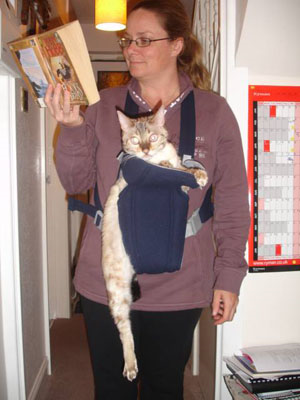
This cat is being held vertically using a Snugli; small dogs can be given food or water this way. Photo Dr. Kathy Morris-Stilwell.
Water should be offered only when the pet is in a vertical position. If your dog is exercising, such as at a dog park, offer water and hold the dog vertically for at least 5 minutes after drinking, and longer for a lot of water. This can be accomplished by training your dog to allow you to hold him vertically with his back resting against your legs. The appropriate amount of water can usually be provided with the food, so the dog doesn’t have to drink from a bowl. Do not allow your pet access to water bowls, toilets, puddles, sinks, etc. If you have multiple pets, you may have to offer water to them several times daily, but not leave water available for the megaesophagus dog. If your pet is dehydrated, or your veterinarian feels that he needs additional fluids at certain times, you can be shown how to give fluids subcutaneously (under the skin, often called SQ or SUBQ). Some dogs are unable to drink water normally because they regurgitate it. Adding water in the food can be helpful. Knox Blocks may be another way of supplementing fluid intake; Thick It or Thick ‘n’ Easy powder can be added to water to make it easier for those dogs to drink. Your veterinarian can compute your pet’s daily fluid and calorie requirements.
Two Knox Blocks recipes to increase fluid intake are:
1 cup cold low-sodium chicken broth.
Stir 4 packages of Knox gelatin into broth.
Add 3 cups of boiling water and stir until dissolved.
Pour liquid into a 9 × 15 casserole dish and refrigerate until solid, approximately 2–3 hours.
Cut the mixture into dice-size cubes.
OR
6 cups boiling water.
8 packets of Knox gelatin.
2 cups chicken broth.
Add Knox packets to chicken broth.
Add gelatin and chicken broth to boiling water. Stir to melt gelatin.
Put in pan and refrigerate. This recipe makes 64 oz. of chicken-flavored gelatin.
Exercise
Some dogs appear to receive benefit from walking 5 to 10 minutes before and/or after food or water. Additionally, most dogs can eventually exercise and play as do healthy dogs. Some dogs in the support group participate in agility and some even go hunting with their owners.
Feeding
Position
Offering food, water and treats with the pet in a vertical position (i.e., sitting up in a begging pose) is one of the most important ways in which to manage these patients. This is a non-negotiable management technique required by almost all pets with megaesophagus. Because the esophagus is paralyzed, if the dog is not fed vertically or is just fed in an elevated position, we cannot take advantage of gravity. Gravity allows food, water, and medications to FALL through the esophagus into the stomach.
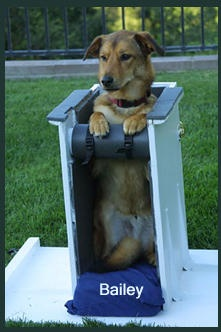
Bailey, whose owner designed the original Bailey Chair, sits ready to eat. Photo by matthew1@earthlink.net, with permission from Dr. Kathy Morris-Stilwell
A Bailey Chair, named for the inventor’s dog, is useful in encouraging appropriate and successful feeding technique. A DVD with building instructions for the Bailey Chair, or an Internet connection to the DVD, can be obtained by contacting matthew1@earthlink.net. The cost of the DVD for the Bailey Chair is $6.60, which includes mailing, although it’s free with Internet access. Other methods of feeding can be seen in the photo section of the support group. Correct construction of the chair is encouraged for both the comfort of the dog and his willingness to use it. Please be patient while teaching your pet to sit in the Bailey Chair – some dogs catch on quickly, and some, more slowly. See Diyoji get into his Bailey Chair and eat in this video. https://www.youtube.com/watch?v=ez710k3796c
Some of the most critical changes the owner of an affected dog must make immediately after diagnosis is the amount of food offered at each feeding; the number of meals per day; and the format. The format should be either liquefied food, blended to a smooth consistency in a blender, or food compressed into meatball form swallowed whole so as to avoid pieces or particles that can irritate the esophageal lining; the irritation increases regurgitation and risk of aspiration. Generally the goal is to get more calories and nutrients into less volume. Cautious trial and error will help the owner determine whether the dog tolerates the blended type – which also assists with consistent hydration of the dog – better, or the meatball type. Most dogs require several smaller meals spaced about three hours apart, while others can work up to larger meals that are provided less frequently. The owner should not try to replace lost weight too quickly on these dogs. First, finding what reliably gets to the stomach and stays down, is key.
Diet
High-fat diets may encourage regurgitation. If you are concerned about putting weight on your pet, it is better to get the regurgitation under control first. Low-fat prescription diets seem to be better tolerated by dogs with megaesophagus, especially at the initial diagnosis. You would not want a high-fiber diet as it can be difficult to maintain body weight on one; we want a low-fat diet that is not high in fiber. Ask your veterinarian for suggestions.
Raw diets are not suggested for these pets because with the increased risk of aspirating regurgitated stomach contents, bacteria in the unprocessed food can be a risk. Additionally, rice also seems to be poorly tolerated by these pets. If you wish to prepare your pet’s food, it is strongly suggested that you contact a veterinary nutritionist (ask your veterinarian for a referral) so that a balanced diet can be created. Many nutritionists also provide appropriate supplements; it is nearly impossible for an owner to collect all of the micro-nutrients that are best for a balanced diet. Adding coconut milk to a diet can add calories as well as liquid.
Many dogs and cats can eventually eat regular pet food once their ideal consistency is discovered. The ideal consistency will produce the least regurgitation. Some pets do well with a watery gruel, some with food formed like meatballs, and some can eat canned dog food. A RARE dog/cat will be able to tolerate dry food. At least when you are first starting to manage these pets, it is best to start with watery or pudding-like food. All pets differ in what food consistency is ideal for them and experimenting is
Most dogs need to be held vertically for 20 to 30 minutes to allow the food and water to descend into the stomach with the help of gravity. Many (5-6) small daily meals may be necessary, especially during the initial management of megaesophagus. Most pets can do well with three daily feedings.
Feed calorie-dense, lower-fat diets. Because fat stays in the stomach longer than protein or carbohydrates, it can encourage more frequent regurgitation into the esophagus from the stomach.
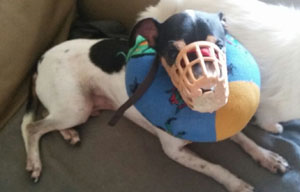
This dog wears a Pro-collar and a basket muzzle – Photo by Dr. Kathy Morris-Stilwell
Access to items that the pet may consider as “food” needs to be restricted: feces, chew bones/rawhides, products on counters, cat food, etc. A basket muzzle may be worn by dogs when outside, if needed (a foot from a nylon stocking may be placed over the muzzle to prevent the dog from licking between the bars of the muzzle). Do not use muzzles that prevent the mouth from opening.
Feeding Tubes
If a pet cannot eat, or continues to regurgitate, a feeding tube may need to be placed. These percutaneous endoscopic gastrostomy (PEG) tubes must be placed while the pet is under anesthesia, and can be inserted quickly by a veterinarian who has some experience. Most can be placed without surgery, but if the esophagus is too damaged or has any strictures, the feeding tube may need to be placed surgically. Unfortunately, many owners wait too long to consider having the tube placed.
Aspiration Pneumonia
Aspiration pneumonia (AP) is one of the most common side effects of megaesophagus, and can quickly become life-threatening. The lungs can become infected quickly. Signs of AP can show up very quickly in these pets, but some can develop symptoms over a few days. Coughing doesn’t always occur initially, so you need to have a high index of suspicion if his appetite decreases or lethargy develops. Aspiration pneumonia can be severe within hours of the initial signs, so seek out veterinary care sooner rather than later. Unfortunately, abnormalities due to AP cannot always be heard with a stethoscope, making x-rays imperative. Three x-ray views are required as the aspiration pneumonia may not be easily perceived with just one or two. To make matters worse, the x-ray signs of AP may not show up for 1 to 2 days. That being said, if there is any suggestion by either clinical signs or x-ray changes, it is better to treat rather than wait as these pets can deteriorate quickly. Appropriate antibiotics should usually be given for 4 to 6 weeks. Recheck x-rays should be taken before discontinuing antibiotics. The best way of determining the ideal antibiotic is for material to be collected directly from the lungs via a transtracheal wash or bronchoalveolar lavage. However, because these are somewhat invasive procedures, veterinarians usually administer empirical (medical best guess) antibiotics. These diagnostic procedures are done only if the AP cannot be brought under control.
Nebulization with albuterol is helpful in treating AP. For your veterinarian, there is an example on how to write a prescription for albuterol at this link. Percussion therapy (coupage) can help break up any debris that is within the lungs. This is also demonstrated at the above link. Nebulizers can be purchased through some pharmacies, medical supply houses, or even on eBay. Useful brands of nebulizers include PulmoMate, PulmoNaide, and Omron. Some owners of dogs who develop frequent AP find that routine, daily nebulization is helpful in curtailing re-infection. An oxygen mask is needed for administration. These can be purchased from your veterinarian. You can make do with a temporary mask created from a plastic glass, even with a Solo cup. Nebulization is not needed in all pets with megaesophagus, but rather for those who develop AP or in whom it frequently recurs.
WARNING: albuterol should not be administered to pets by people who have heart or lung disorders. Ask your physician if it is safe for you to be exposed to albuterol.
Albuterol is used in inhalers and nebulizers to treat asthma and other lung disorders in people and in animals.
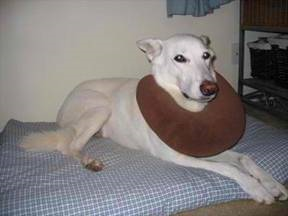
This dog sleeps wearing a Procollar. Photo courtesy of Dr. Kathy Morris-Stilwell.
Sleeping
Having pets sleep with their front end elevated and/or wearing a balloon-type collar to keep their head elevated may help not only with the treatment of AP, but may minimize future attacks. These techniques may minimize the flow of nighttime regurgitation into the back of the throat, and therefore minimize micro-aspiration. When pets lay down, material from the stomach can flow into the esophagus and then into the back of the throat. That material can then be inhaled into the trachea and lungs. By having the pet wear a Pro-collar (neck hug, neck balloon) the head is kept elevated so that less can trickle down into the lungs causing a sort of micro-aspiration. Some pets wear these only at night; others wear them 24/7. They can be purchased at pet stores, over the Internet or can be hand made.
Surgery and Dentistry
Most owners are afraid of having any anesthetic procedures performed on their pets with megaesophagus. With a few precautions, surgical and dental procedures can be performed safely under anesthesia. Ask your veterinarian to follow these suggestions to minimize any problems.
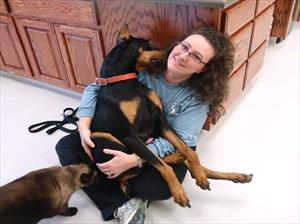
Dyer is held vertically by his owner after his neuter surgery – Photo by Dr. Kathy Morris-Stilwell
In dogs who can tolerate it, pre-treat with metoclopramide one half-hour before anesthesia induction to encourage the stomach to empty. Elevate the head end of the surgical table or place the patient on a slant so that the head is above the rear end. This minimizes reflux of stomach contents into the esophagus.
It’s important to leave the endotracheal tube in until the dog is actively swallowing to minimize aspiration. Maintain elevation of the pet’s front end, preferably in a vertical position (body perpendicular to the floor) while recovering from anesthesia. This vertical elevation allows any fluid that has accumulated in the esophagus to drain into the stomach. Any fluid build-up in the esophagus can be easily refluxed and cause AP in dogs who have megaesophagus. Preventing regurgitation at all costs is critical.
Treats and Training
Most pets with megaesophagus cannot receive normal treats. Many dogs produce a large amount of saliva if they even smell food or treats, causing regurgitation. Your attention is probably your pet’s best treat. Verbal praise and petting can be a successful training tool.
Resolution of Megaesophagus
Many owners are hopeful that their pet’s megaesophagus will resolve, especially if it is caused by another disorder. Although possible, this only happens about 15 percent of the time it occurs in older dogs. We do see some German shepherd puppies outgrow their megaesophagus, but that is rare. Megaesophagus is usually a lifetime disorder. These dogs can live high-quality lives, especially if their individual management protocol can be developed. Owners frequently wonder how long their dogs can live with megaesophagus, and the answer is that as long as they can be kept at a good weight and aspiration pneumonia attacks can be controlled, these dogs can live fairly long, normal lives. For example, Bailey, of the Bailey Chair fame, died of lung cancer at almost 13 years of age.
